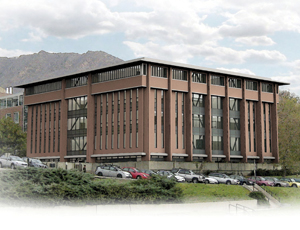The University of Utah College of Nursing Annette Poulson Cumming Building is undergoing an extensive $15-million renovation by Jacobsen Construction of Salt Lake City. Built in 1967, this project will completely renovate the five-story (plus one floor of below grade parking), 88,070-sq-ft building. Technical deficiencies in the infrastructure are being addressed and environments that support the educational and research functions of the college are being created.

Work includes asbestos abatement, seismic retrofit, the replacement of nearly all interior walls and finishes, the complete replacement of all infrastructure including HVAC, plumbing, electrical, telecommunications, audio/visual, security, lighting and new interior finishes. The project, designed by Salt Lake-based GSBS Architects, is aiming for LEED Silver certification, and exceeds the criteria of the State of Utah High Performance Building Rating System while meeting the University’s goals for sustainable design and energy efficiency. Construction will be completed at the end of July 2010.
The renovated College of Nursing building will be organized to facilitate two primary functions – student learning and faculty research. Student learning environments, including the Simulation Learning Center and classroom space will be located on the first and second floors. The third and fourth floors will be dedicated to faculty and staff office space. The fifth floor will be dedicated entirely to research faculty.
The project is aiming for LEED Silver certification that will be achieved in several key areas including energy efficiency, water use reduction, construction waste recycling and indoor environmental quality.
The energy performance and comfort of the building will be achieved by a complete removal of the existing dual duct HVAC system, the installation of a more efficient and controllable VAV reheat system, the installation of a new air handler that includes a direct cooling coil, the use of the campus system of high temperature and chilled water, the removal of all outdated lighting and significant improvements to the building envelope including insulation of the exterior wall and window replacement. Energy modeling has determined that this design approach will result in a 27% savings electrical usage and 5% savings in natural gas usage over the code dictated construction.
The seismic reinforcement of the existing College of Nursing building significantly impacts the overall design. Steel cross bracing located on the perimeter of the building will reinforce the existing structural system. In these areas the existing brick wall and existing windows have been removed and will be replaced with a high-performance glass curtain wall system. This creates a significant opportunity to allow daylight to enter the building and offers opportunities to organize the floor plan around this new source of natural light. In the areas unaffected by bracing, the existing exterior wall system will remain and will be re-insulated to improve the thermal performance of the wall. All existing windows will be replaced to further improve energy performance and improve daylighting.
Significant amounts of construction debris are being recycled. During the demolition and abatement phase of the work 94% of non-hazardous materials were recycled. This amounted to 240 tons of wood, steel and other metals. Current on site recycling activities require subcontractors to sort paper, plastic, cardboard, metal and concrete.
Layton Construction’s Boise office recently wrapped up a new $4.5 million University of Phoenix project in Meridian, Idaho. Designed by CSA Architects of Las Vegas, the 36,565 sq ft, 2-story building includes classrooms and administrative spaces. The exterior is a steel structure with a brick veneer, glazing and composite metal panel. Interior finishes consist of painted gypsum board walls along with carpet and stone tile flooring.
The project is noteworthy since it is the first project for University of Phoenix aiming for LEED certification.
“It has been great to work with an owner who continues to demand a high level of quality and strong commitment to sustainability,” says Jeremy Hobbs of Layton Construction. The project was completed in October.

Post a comment to this article
Report Abusive Comment